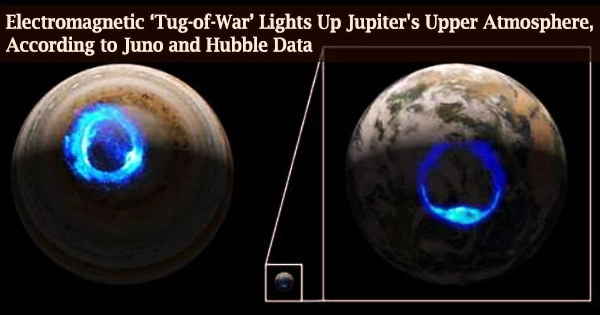Using data from NASA’s Juno probe and the Hubble Space Telescope, new Leicester space research has revealed for the first time that a complex ‘tug-of-war’ lights up aurorae in Jupiter’s upper atmosphere.
The delicate current cycle produced by Jupiter’s rapid rotation and the discharge of sulphur and oxygen from volcanoes on its moon, Io, is described in the study, which was published in the Journal of Geophysical Research: Space Physics.
Data from Juno’s Magnetic Field Investigation (MAG), which measures Jupiter’s magnetic field from orbit around the gas giant, and observations from the Hubble Space Telescope’s Space Telescope Imaging Spectrograph were used by researchers from the University of Leicester’s School of Physics and Astronomy.
Their findings provide the best evidence yet that Jupiter’s intense aurorae are linked to an electric current system that tugs at the material in the planet’s magnetosphere, which is controlled by the planet’s massive magnetic field.
Dr. Jonathan Nichols is a Reader in Planetary Auroras at the University of Leicester and the corresponding author for the study. He said:
“We’ve had theories linking these electric currents and Jupiter’s powerful auroras for over two decades now, and it was so exciting to be able to finally test them by looking for this relationship in the data. And when we plotted one against the other I nearly fell off my chair when I saw just how clear the connection is.”
“It’s thrilling to discover this relation because it not only helps us understand how Jupiter’s magnetic field works, but also those of planets orbiting other stars, for which we have previously used the same theories, and now with renewed confidence.”
Having more than five years of in-orbit data from the Juno spacecraft, together with auroral imaging data from the HST, we now have the material to hand to look in detail at the overall physics of Jupiter’s outer plasma environment, and more is to come from Juno’s extended mission, now in progress. We hope our present paper will be followed by many more exploring this treasure trove for new scientific understanding.
Stan Cowley
Jupiter rotates once every nine and a half hours, despite its enormous size, having a diameter more than 11 times that of Earth.
Io is the same size and mass as Earth’s moon, although it orbits Jupiter at a distance of 422,000 kilometers, or around 10% further away. Io is the most geologically active object in the Solar System, with over 400 active volcanoes.
Scientists had hypothesized a link between Jupiter’s aurorae and the material blasted from Io at a rate of hundreds of kilos per second for a long time, but Juno’s data was equivocal.
Dr. Scott Bolton, of NASA’s Jet Propulsion Laboratory (JPL), is the Principal Investigator (PI) for the Juno mission. He said:
“These exciting results on how Jupiter’s aurorae work are a testament to the power of combining Earth-based observations from Hubble with Juno measurements. The HST images provide a broad overview, while Juno investigates close up. Together they make a great team!”
The planet’s fast revolving magnetic field propels much of the material discharged from Io out from Jupiter, and as it goes outward, its rotation rate slows. Jupiter seeks to maintain this material spinning at its rotation speed via a system of electric currents flowing through the planet’s upper atmosphere and magnetosphere, resulting in an electromagnetic tug-of-war.
Jupiter’s major auroral emission was assumed to be driven by a component of the electric current flowing out of the planet’s atmosphere, transported by electrons fired downward along magnetic field lines into the upper atmosphere.
Prior to Juno’s arrival, however, this theory had never been tested because no spacecraft with suitable equipment had ever orbited Jupiter close enough. And, while such signatures have since been discovered, one of the major discoveries of Juno’s mission has been to indicate that the nature of the electrons above Jupiter’s polar regions is much more complex than was originally predicted.
During the early phase of Juno’s mission, the researchers contrasted the brightness of Jupiter’s major auroral emission with simultaneous measurements of the electric current flowing away from the Solar System’s largest planet in the magnetosphere.
Instruments on board the Hubble Space Telescope in Earth orbit witnessed these aurorae. The scientists proved the association between auroral intensity and magnetospheric current strength by comparing dawn-side current data with the brightness of Jupiter’s aurorae.
Stan Cowley, Emeritus Professor of Solar-Planetary Physics at the University of Leicester and study co-author, has spent the last 25 years studying Jupiter’s spectacular aurorae. Professor Cowley added:
“Having more than five years of in-orbit data from the Juno spacecraft, together with auroral imaging data from the HST, we now have the material to hand to look in detail at the overall physics of Jupiter’s outer plasma environment, and more is to come from Juno’s extended mission, now in progress. We hope our present paper will be followed by many more exploring this treasure trove for new scientific understanding.”





